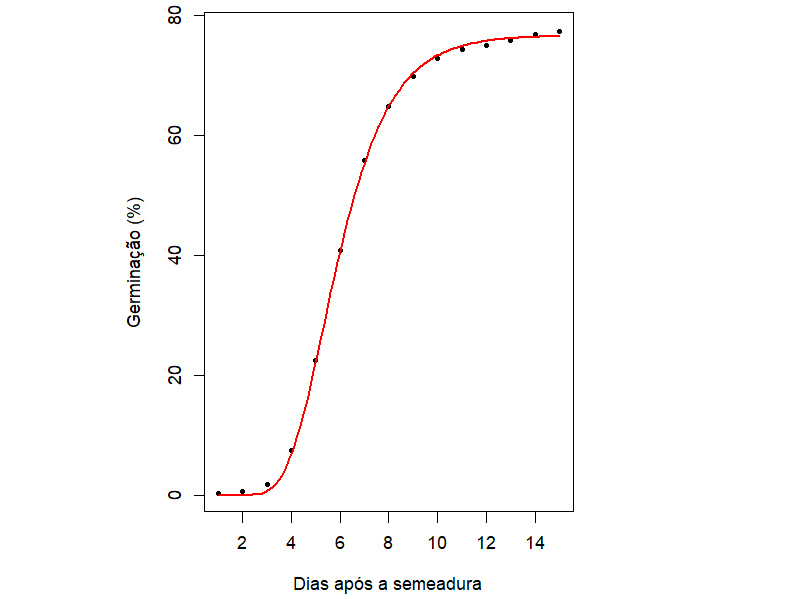Description of weed germination curves at different temperatures using nonlinear models
Keywords:
Gompertz model, Logistic model, Amaranthus, critical points, seedsAbstract
The spread of weeds can occur in various ways, both through seeds that can detach from plants already present in the area and be carried by machinery, wind, animals, and humans. The use of statistical models can help in a better understanding of the cumulative seed germination process and aid in the management system. The objective of this study was to use the non-linear Logistic and Gompertz models, evaluating which one is more suitable to describe the cumulative germination curve of three weed species, as well as exploring the first to fourth-order derivatives to analyze the critical points of the curves. The following conditions were used: photoperiod (8 hours of light/16 hours of darkness) with temperature (alternating or constant), and the percentage germination of seeds was evaluated at 2, 4, 6, 8, 10, 12, and 14 days after sowing. The model parameters were estimated using the method of least squares with the iterative Gauss-Newton method. The quality of fit was assessed using the coefficient of determination, residual standard deviation, and Akaike information criterion, through R software. The Gompertz model was found to be the most suitable for describing the data. Under both germination conditions, the species A. viridis showed the lowest and highest values of $\beta$ and $k$, respectively, followed by A. spinosus and A. deflexus. Regarding critical points, A. viridis showed the earliest germination, but A. spinosus had the highest germination percentage.
References
ACHIM, Z.; TORSTEN, H. Diagnostic checking in regression relationships. R News, v.2, n.3, p.7-10, 2002. Available from: URL https://cran.r-project.org/web/packages/lmtest/index.html.
CARVALHO, S. et al. Suscetibilidade diferencial de plantas daninhas do gênero amaranthus aos herbicidas trifloxysulfuron-sodium e chlorimuron-ethyl. Planta daninha, v. 24, p. 541–548, 2006.
CARVALHO, S. J. P.; CHRISTOFFOLETI, P. J. Influência da luz e da temperatura na germinação de cinco espécies de plantas daninhas do gênero Amaranthus. Bragantia, v. 66, p. 527-533, 2007.
CARVALHO, S. J. P.; LÓPEZ-OVEJERO, R. F.; CHRISTOFFOLETI, P. J. Crescimento e desenvolvimento de cinco espécies de plantas daninhas do gênero amaranthus. Bragantia, v. 67, n. 2, p. 317–326, 2008.
DE BRITES SENRA, J. F. et al. Seleção de modelos não lineares e o estudo do crescimento dos frutos de café conilon. Research, Society and Development, v. 11, n. 4, p. e21511427093-e21511427093, 2022.
FERNANDES, T. J. et al. < b> parameterization effects in nonlinear models to describe growth curves. Acta Scientiarum. Technology, v. 37, n. 4, p. 397–402, 2015.
FRÜHAUF A. C. et al. Nonlinear models in the study of the cedar diametric growth in a seasonally dry tropical forest. Revista Brasileira de Ciências Agrárias, v. 15, n. 4, p.1-8, 2020.
FRÜHAUF, A. C. et al. Description of height growth of hybrid eucalyptus clones in semi-arid region using non-linear models. Brazilian Journal of Biometrics. v. 40, n. 2, p. 138-151, 2022.
JOHN, F.; SANDFOR W. An R companion to applied regression. 3rd ed. Thousand Oaks: Sage, 2023 Available from: URL https://cran.r-project.org/web/packages/car/index.html.
JUNIOR, R. d. O.; CONSTANTIN, J.; INOUE, M. H. Biologia e manejo de plantas daninhas. Curitiba, PR: Omnipax, p. 348, 2011.
KLEINPAUL, J.A. et al. Productive traits of rye cultivars grown under different sowing seasons. Revista Brasileira de Engenharia Agrícola e Ambiental v. 23, n.12, p. 937-44 , 2019.
MELLO, A. C. et al. Nonlinear models in the height description of the Rhino sunflower cultivar. Ciência Rural, v. 52, n. 3, 2022.
MISCHAN, M. M.; PINHO, S. Z. d. Modelos não lineares: funções assintóticas de crescimento. São Paulo: Cultura Acadêmica, 2014. 184 p.
MONQUERO, P. A.; CHRISTOFFOLETI, P. J. Banco de sementes de plantas daninhas e herbicidas como fator de seleção. Bragantia, v. 64, p. 203-209, 2005.
PINHEIRO, J. et al. Linear and nonlinear mixed effects models. 2023. Available from: URL https://cran.rproject.org/web/packages/nlme/index.html.
PRADO, T. K. L. et al. Study on the growth curve of the internal cavity of ‘Dwarf green’coconut fruits. Revista Ciência Agronômica, v. 51, n. 3, p. e20154591, 2020.
R CORE TEAM. R: A language and environment for statistical computing. R Foundation for Statistical Computing, Vienna, Austria. 2023. URL https://www.R-project.org/.
SILVA, É. M. D. et al. Evaluation of the critical points of the most adequate nonlinear model in adjusting growth data of ‘green dwarf’coconut fruits. Revista Brasileira de Fruticultura, v. 43, n. 1, p. e-726, 2021.
SILVA, É. M. d. et al. Description of blackberry fruit growth by nonlinear regression models. Revista Brasileira de Fruticultura, v. 42, n.2, p. e-177, 2020.
SILVA E. M.et al. Método de Newton e Gauss-Newton na estimação dos parâmetros de modelo de regressão não linear. Sigmae, v. 8, n. 2, p. 728-734, 29 Jul. 2019.
SOUSA, I.F. et al. Fitting nonlinear autoregressive models to describe coffee seed germination. Ciência Rural. v. 44, p. 2016-2021, 2014.
TEIXEIRA, G. L. et al. Growth curves of campolina horses using nonlinear models. Livestock Science, Elsevier, v. 251, p. 104631, 2021.

Downloads
Published
How to Cite
Issue
Section
License
Proposta de Política para Periódicos de Acesso Livre
Autores que publicam nesta revista concordam com os seguintes termos:
- Autores mantém os direitos autorais e concedem à revista o direito de primeira publicação, com o trabalho simultaneamente licenciado sob a Licença Creative Commons Attribution que permite o compartilhamento do trabalho com reconhecimento da autoria e publicação inicial nesta revista.
- Autores têm autorização para assumir contratos adicionais separadamente, para distribuição não-exclusiva da versão do trabalho publicada nesta revista (ex.: publicar em repositório institucional ou como capítulo de livro), com reconhecimento de autoria e publicação inicial nesta revista.
- Autores têm permissão e são estimulados a publicar e distribuir seu trabalho online (ex.: em repositórios institucionais ou na sua página pessoal) a qualquer ponto antes ou durante o processo editorial, já que isso pode gerar alterações produtivas, bem como aumentar o impacto e a citação do trabalho publicado (Veja O Efeito do Acesso Livre).



